
US$4.9 million per launch
Though there have been tremendous advances in space technology in recent years, when it comes to getting into space, we’re still like cavemen trying to get beyond the breakers on a floating log – at least, that’s the view of New Zealand-based company Rocket Lab. In the hopes of increasing the number of satellite launches to over 100 a year and placing constellations of small satellites into orbit numbering in the thousands, the company has developed a “battery-powered” rocket engine to lift its Electron launch vehicle at almost a tenth of the cost of conventional boosters.
Liquid rocket engines are hungry beasts that require huge quantities of propellants for every second of flight. To manage this, engines use turbopumps to feed propellants into the combustion chamber. In a conventional design, a centrifugal or axial-flow turbopump is driven by a gas turbine. This has done the job very well since the first rocket turbopumps were developed in the 1940s, but they’re complex, heavy affairs that need their own fuel systems to operate.
Rocket Lab’s idea for making a lighter, simpler liquid rocket is its Rutherford engine. Named after New Zealand-born physicist Ernest Rutherford, it’s an electric turbopump engine that burns a mixture of liquid oxygen and RP-1 rocket fuel, which is a highly refined type of kerosene. Unlike conventional engines, in the Rutherford, the gas-powered turbine to run the pump is replaced with a brushless DC motor and lithium polymer batteries, and provides enough fuel for the Rutherford to generate 4,600 lbf (20,462 N) of thrust and a specific impulse of 327 seconds.
The company says that the Rutherford is also notable as the first oxygen/hydrocarbon engine to use 3D printing for all its primary components, including the regeneratively cooled thrust chamber, injector, pumps, and main propellant valves.
Read more: “World’s first battery-powered rocket” readied for launch
The Latest on: Space launch systems
[google_news title=”” keyword=”Space launch systems” num_posts=”10″ blurb_length=”0″ show_thumb=”left”]
via Google News
The Latest on: Space launch systems
- Indian-American astronaut Sunita Williams gives insight into 1st crewed Boeing Starliner launch: ‘It feels unreal’on May 2, 2024 at 8:03 am
Indian-origin Sunita Williams and Butch Wilmore -- are all set to make their way to space in first crewed Boeing's Starliner spacecraft.
- Europe is falling behind in the race to develop space-based solar poweron May 2, 2024 at 7:03 am
Space-based solar power could help solve some of the energy transition woes plaguing Europe. But is it too good to be true?
- NASA Astronauts Brace for Historic Night Launch Aboard Boeing’s Starlineron May 2, 2024 at 12:07 am
Astronauts Butch Wilmore and Suni Williams are preparing for a historic flight aboard Boeing's Starliner spacecraft to the International Space Station. NASA astronauts Butch Wilmore and Suni Williams ...
- Morning launch from Vandenberg SFB scheduled for Thursday; sonic booms expectedon May 1, 2024 at 11:12 pm
SpaceX is targeting May 2 for a Falcon 9 rocket launch from Space Launch Complex 4 East to carry two Maxar WorldView Legion satellites to low-Earth orbit. The 14-minute window ...
- 'It almost feels unreal': NASA astronauts excited for 1st crewed Boeing Starliner launch May 6on May 1, 2024 at 1:00 pm
"I don't think either one of us ever dreamed that we'd be associated with the first flight of a brand-new spacecraft." ...
- Massive space strategy game set to launch on Steam this summeron May 1, 2024 at 8:40 am
Sins of a Solar Empire 2 adds a new dynamic galaxy map, enhanced real-time combat, minor factions, in-game mod browser, and an all-new economic system.
- 321 Launch: Space news you may have missed over the past week (April 30)on April 30, 2024 at 12:50 pm
Launch recap: Scroll down to review live coverage of the Sunday, April 28, liftoff of a SpaceX Falcon 9 rocket from Cape Canaveral. Read the full story here.
- SpaceX vet's startup Portal Space Systems comes out of stealth modeon April 30, 2024 at 6:01 am
A spaceflight startup with some serious bona fides has just come out of stealth mode. Portal Space Systems announced its existence today (April 30), revealing that it has snagged more than $3 million ...
- NASA Unveils Game-Changing Electric Propulsion Technology for Future Space Missionson April 29, 2024 at 12:42 pm
NASA's innovative propulsion technology propels small spacecraft exploration and extends satellite lifetimes, supporting U.S. leadership in space technology. NASA has developed an advanced propulsion ...
- SpaceX launch recap: Starlink mission Sunday from Cape Canaveral Space Force Station in Floridaon April 28, 2024 at 4:22 pm
Live updates from Sunday evening's SpaceX Starlink 6-54 mission that launched a Falcon 9 rocket from Cape Canaveral Space Force Station in Florida.
via Bing News











